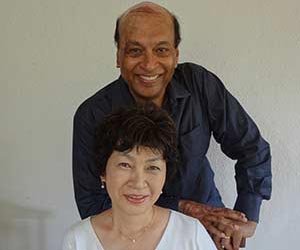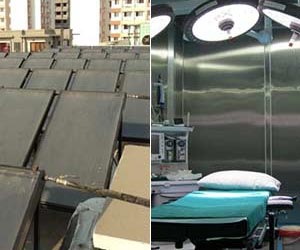 Winners: Larsen & Toubro Limited
Winners: Larsen & Toubro Limited
Larsen & Toubro is a technology, engineering, construction, manufacturing and financial services conglomerate, with global operations. One of the largest and most respected companies in India’s private sector, it is ranked 4th in the global list of Green Companies in the industrial sector by the reputed international magazine Newsweek, and ranked the world’s 9th Most Innovative Company by Forbes International.
With offices across India and overseas, L&T has one of its best campuses in Knowledge City, Vadodara. Spread across 112-acre, this state-of-the-art engineering campus meets the high-end design and engineering needs of the hydrocarbon and power sectors. Today it provides employment to around 4000 professionals.
The energy saving initiative in question has been carried out in this campus. L&T Knowledge City has been designed and built to high environmental standards, incorporating systems for rainwater harvesting, waste-water management and utilization of solar energy.
Energy conservation is in our organisation’s DNA. The NDTV Mission Energy Challenge is a noble national endeavour and our participation would reinforce the desire of our people to align themselves with the energy-saving activities by innovative ways to minimise energy consumption for a national cause.
The NDTV Mission Energy Challenge acted as a catalyst for innovative technology-oriented energy saving initiatives. Energy awareness campaigns also helped in changing people’s attitude towards energy consumption and reinforce the belief that it is a national imperative. Variable Frequency Drive (VFD) control of Air Handling Units (AHUs), motion sensor installation at working floor area of buildings are the steps taken towards energy conservation helped achieve reduction in power consumption. To ensure that the benefits accrued are not reversed, we even reduced our contractual demand.
CESC Ltd, a flagship company of RP-Sanjiv Goenka Group, is a fully integrated power utility with its operation spanning the entire value chain: right from mining coal, generating power, distribution of power. It serves 2.8 million customers within 567 square kilometers of Kolkata and Howrah, delivering safe, cost-effective and reliable energy to its consumers.
CESC House is headquarter of CESC Ltd. It is an 80 year old Heritage Building built in year 1933 with gross floor area of over 72,000 ft². There are Ground + 5 floors of office area. On an average, 540 no’s full time employees occupies the building with 500+ supporting staffs and others.
CESC has been actively involved in delivering electricity in an environment friendly way and it has been taking all efforts to ensure that its power plant are highly energy efficient.
CESC House has seen its electricity consumption growing at a rate of 2% p.a. from 29 lacs kWh in 2006 to 33 lacs kWh in 2012.
CII- NDTV Mission Energy Challenge is a great opportunity for CESC to endorse its corporate identity as a Responsible Business Group which could be showcased to its consumers. Over the span of two months, CESC House has been able to adopt many world class green practices. Positive results of the initiatives are immense.
Along with saving of 2 lakh units of energy, 3.5 lac litres of water and 288 tonne of CO2 has also been saved from going into the atmosphere. It has motivated employees to take all the future decisions in Green Way. 500 D lights were installed in common areas of entire CESC House. This will result in a saving of 80,000 units of energy per year which is equivalent to 4500 no. of trees planted. This will also save 120 tones of CO2 from going into the atmosphere.
Occupancy sensor has been installed which switches off cabin lights within minutes when occupant leaves his/her room. These are both motion and lux sensors.
Installation of Water Management System for cooling tower. This is saving 59,000 units of energy per year which is equivalent to 3300 trees planted. This will also save 90 tones of CO2 from going into the atmosphere.
 Runners Up: Bougainvilla Hermitage Retirement Village- Goa
Runners Up: Bougainvilla Hermitage Retirement Village- Goa
Bougainvilla Hermitage hinges on the slogan “Independent, but not Alone”. The concept originated from the need of the upper-middle class in Goa who did not want to spend their twilight years in an old aged home. Bougainvilla Hermitage offers a lifestyle that many of the present generations of retirees expect.
Bougainvilla Hermitage was conceived as a Green Project, right from inception. Our motive to conserve natural energy and environment at large has always been at the helm of Bougainvilla project, and participating in the NDTV Mission Energy Challenge, has helped us inspire more minds to achieve this noble cause.
The two month Challenge has indeed been quite beneficial. Savings have been achieved not just financially, but have influenced the residents and staff, who are proud to be a part of this Green Project, to make a conscious effort in preserving the bountiful resources of Mother Earth for future generations. Installation of Solar Panels, UPCV doors & windows to increase natural lighting and ventilation, sewage treatment and bio gas plant, water treatment plant helped me in saving energy.
 Runners Up: Kohinoor City Hospital
Runners Up: Kohinoor City Hospital
Kohinoor Hospital is Asia’s first LEED Platinum Certified hospital and the world’s second LEED Platinum Certified hospital. We believe in green/sustainable projects as, in today’s age conservation and thoughtful use of resources is very crucial. I would specifically wish to add, that it was not only the ratings/award, the name and fame that prompted us to go for Green – Platinum. It is also his foresight that green is the future of all the commercial projects to come. At Kohinoor Hospital, of all the materials used, more than 40% is recycled material.
The foundation of the overhead tank was built reusing scrap material. Salvaged wood was reused for making frames which helped to conserve trees. The hospital is built with an emphasis on getting natural lights in all the patient areas, which reduces the consumption of electricity. The large windows and open sky light keep the area cool and ventilated along with incoming natural light.
The hospital also has initiatives for water recycling and conservation where the water efficiency mechanism is implemented and conserves more than 40% of water. In this system the waste water from various zones of the hospital is treated using disinfectants at the Sewage Treatment Plant. The water is then reused for flushing, cooling air conditioning, towers and for horticulture. Besides these we also have dual flushes and urinal sensors in place to control water flow. The hospital has installed state-of-the-art Demand Control Ventilation and Variable Air Volume systems to keep indoor air quality in check. VAVs have high-end sensors to provide the right quantity of cool air required for specific building zones.
Many measures are taken to help conserve energy at the Kohinoor Hospital such as high efficiency fluorescent lights, motion sensors to turn off lights and high efficiency air conditioning equipment. Enough energy is saved by the hospital to power, approximately 300 average homes in Mumbai daily. Also, the hospital has reflective roof material that helps decrease the hospital’s urban heat island effect and reduce the amount of energy used for air conditioning.
“By going green, we achieved energy savings up to 30 to 35 per cent over the Ashrae standard which is the base of building design standard.
The whole purpose behind sustainable building is to preserve our environment and avoid the depletion of the earth’s natural resources, protect the ecosystem, reduce emissions, improved air and water quality. Not only does sustainable building improve the quality of our environment but it also has many economic benefits as well. By using sustainable materials, reducing energy consumption, and improving water efficiency.


